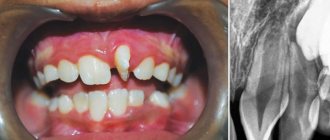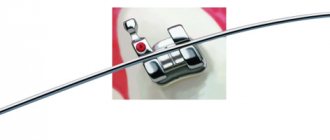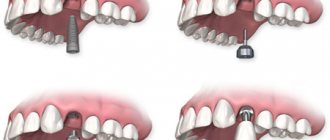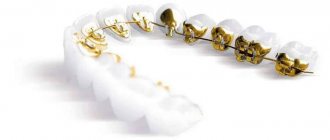The duration of wearing braces frightens many orthodontic patients. Therefore, the most common question that a dentist is asked is how long you need to wear braces to correct your bite. This period will be different for different people. We will tell you in the article what factors determine the maximum and minimum period of wearing braces.
In this article
- What is the bite like?
- Distal bite: how many years do you wear braces to correct it?
- Open bite: how long should you wear braces?
- Mesial bite: how long does it take to correct?
- How long to wear braces for deep bites?
- How long do you wear braces for a crossbite?
- Other factors that affect the length of time you wear braces
- Different braces - how long to wear?
- How long does it take to wear braces depending on age?
- The influence of other factors on the time of bite correction
- Stages of bite correction
- Conclusion
What is the bite like?
Bite (occlusion) is the position of the lower and upper dentition relative to each other when closing. We are talking not only about the position of the teeth, but also the joints and muscles during speech and chewing.
The bite can be normal (physiological), when the teeth close evenly or incorrectly.
How long it will take to correct a bite with braces largely depends on the type of violation of the normal closure of the teeth. The main types of abnormal bite that may require correction with braces include:
- distal;
- open;
- mesial;
- deep;
- cross.
Let's look at each type of bite in more detail. This will help you better understand why in some cases it is necessary to wear braces for a long time.
Distal bite: how many years do you wear braces to correct it?
This type of bite is considered one of the most complex and at the same time common dental anomalies. With this type of closure, the upper teeth protrude noticeably above the lower teeth, and the chin appears small relative to other parts of the face. How strongly the distal bite is expressed can be determined by the “sixes” - the sixth teeth in a row. If, when closing, the upper chewing tooth comes into contact only with the “six” on the lower jaw, this indicates a mild degree of violation. If it comes into contact with two teeth of the lower jaw at once, it is severe. It is easiest to treat distal occlusion in childhood and adolescence, when the jaw continues to form and the teeth are more pliable.
Braces for patients with distal occlusion are most often prescribed as part of complex orthodontic treatment, along with methods that change the shape of the jaw. Thus, adolescents may be prescribed a Frenkel apparatus to correct the upper jaw. To speed up the growth of the lower jaw, the orthodontist may recommend wearing a palatal expander, plate or special trainer.
In adults, the jaw is formed; its position can no longer be changed. But you can use braces to slightly correct the position of your teeth. How long you will have to wear braces to correct a distal bite depends on your age and the severity of the problem. On average, the minimum period of wearing braces for such an anomaly is about 1.5-2 years.
Comments
Can doctors use different types of orthodontic treatment when correcting teeth?
Makarova Inna (06/15/2019 at 12:14) Reply to comment
- Dear Inna! Indeed, in some clinical cases and for better treatment results, doctors can combine different types of orthodontic devices. This is often practiced when correcting malocclusion in children. For example, until the age of 12-13, children wear plates, and after this age they switch to braces. In adults, there may be a similar situation: the doctor may first use trainers or surgical treatment and only then recommend the installation of braces.
Editorial staff of the portal UltraSmile.ru (06/20/2019 at 10:24 am) Reply to comment
How long should you wear braces if you have a malocclusion if you are already satisfied with the results? I mean, is it possible to take it off earlier if, in my opinion, the aesthetic problem has already been solved, or should I wear it “until victory”?
Rita (07/15/2019 at 09:09) Reply to comment
Hello, please tell me how long should I wear braces?
Yu666yuyu (07.15.2019 at 18:31) Reply to comment
Can you please tell me how long I need to wear braces? It’s just that my husband’s 2 front teeth go back a little, so we want to straighten them out. What advice would you give in this case?
Katerina (07/15/2019 at 22:33) Reply to comment
How long does a child need to wear braces to straighten his front teeth? Also, is it worth putting braces on baby teeth? How to choose the right braces and how much will it cost?
Olesya (07/15/2019 at 22:38) Reply to comment
I decided to get braces at age 20. How long do you need to wear braces and is it possible to get transparent ones so that they are not so visible? How much will braces and their installation cost? How often will you need to visit the dentist then?
Nadezhda (07/22/2019 at 14:55) Reply to comment
My son will most likely need braces because he now has crooked teeth from sucking on a pacifier for so long. The question is how long should we wear braces and will they cost us a lot?
Katerina (08/14/2019 at 04:38 pm) Reply to comment
If my top row of teeth are significantly crooked, how long will I need to wear braces to correct the problem? I would also like to clarify how much discomfort I will experience while eating?
Maya (08/14/2019 at 06:23 pm) Reply to comment
My husband has several problems with his upper and lower teeth. The top two teeth go a little inward, we are thinking when the finances will be better to get him braces. Just wondering how long he will have to wear braces then?
Ekaterina (08/15/2019 at 00:06) Reply to comment
If a teenager has severely crooked teeth, how long does it take to wear braces in order for a positive result to begin to be observed, and how is teeth cleaned with braces?
Ilisha (08/20/2019 at 10:04 pm) Reply to comment
How long do you need to wear braces in order to straighten your lower teeth, one tooth is generally very concave in the inside. How are braces made and how much do you have to pay for them?
Loris A (08/20/2019 at 10:07 pm) Reply to comment
Write your comment Cancel reply
Open bite: how long should you wear braces?
With an open bite, a noticeable gap forms between the teeth. As a rule, it is located in the area of the front teeth and greatly affects the aesthetics of the smile. In addition, with an open bite, the patient may have a lisp, the tongue may fall out of the gap, which reduces the quality of life and affects self-esteem.
It is very difficult to treat open bites on permanent teeth, so the best option is to see an orthodontist in childhood. There are two main methods of treatment - with braces and with surgery. Sometimes doctors combine both methods: first, they correct the position of the teeth using a braces system, and then perform surgery on the jaws. The recommended period for wearing braces to correct an open bite is 2 years or longer.
Mesial bite: how long does it take to correct?
With such an anomaly in the closure of the teeth, the lower jaw protrudes forward, and the teeth of the lower row overlap the teeth of the upper one. Mesial occlusion significantly affects facial aesthetics. If the incisors of the two jaws do not meet, this can lead to problems with diction, speech and chewing.
It is impossible to slow down the growth of the lower jaw using dental methods. Therefore, with such a violation, the orthodontist most often decides to stimulate the growth and expansion of the upper jaw. To do this, braces are placed on the first molars and permanent incisors.
How long they are worn depends on various factors. For some, bite correction occurs after 1 year, for another patient it takes 2 years.
How long to wear braces for deep bites?
A deep bite is a type of abnormal bite in which the upper teeth overlap the lower teeth by more than a third. This disrupts chewing function, contributes to damage to tooth enamel, and can lead to soft tissue trauma. Different treatment methods are suitable for correcting deep bites, depending on the age of the patient and the severity of the disorder.
Children from 6 to 11 years old are most often given plates that correctly guide the growing jaw. In most cases, braces are used to correct deep bites in adolescents and adults. Braces are worn for deep bites for an average of one and a half years.
In difficult cases, orthodontic treatment is not enough and the patient may require surgery.
Other factors that affect the length of time you wear braces
The type of bite and the severity of the orthodontic defect are not the only factors that determine how long to wear braces. The following points also affect the timing:
- type of orthodontic structure;
- patient's age;
- individual characteristics of the body of a particular patient;
- quality of hygienic care for braces.
How to care for braces
To reduce the likelihood of developing dental diseases, the patient will have to carefully monitor their diet and oral hygiene. In particular, it is necessary to avoid hard and sticky foods, foods with dyes and smoking. If possible, you should limit your consumption of sweets. For oral care you should purchase:
- a brush with V-shaped bristles (CURAPROX Ortho);
- brush (Curaprox CPS 10, Biorepair Scovolini Interdentali Cilindrici);
- dental floss (Mirafloss implant chx);
- rinse aid with antibacterial properties (Biorepair Mouthwash).
It is advisable to use toothpastes without abrasive substances and periodically (2-3 times a week) clean the oral cavity with an irrigator. To do this, purchase devices that are suitable for caring for orthodontic structures: Little Doctor International Ltd Aquajet LD-A7, Donfeel Donfeel OR-820D Compact, Revyline RL100, Donfeel Donfeel OR-888, Panasonic EW-1411, Revyline RL 200XL, etc.
Different braces - how long to wear?
Modern dentistry offers a huge selection of brace systems of various designs, made from different materials, with varying strength and aesthetic properties. All of these factors can affect the length of time you wear braces.
- Metal braces.
This system is considered the most durable and puts maximum pressure on the teeth. The main disadvantage is that these braces are noticeable to others and affect your appearance. On average, they are worn from one to one and a half years.
- Ceramic braces.
They look aesthetically pleasing, invisible to others, and have good strength. But they do not put as much pressure on the teeth as metal ones. Therefore, the period of wearing such braces is usually several months longer. On average it ranges from one to three years.
- Sapphire designs.
The characteristics are similar to ceramic ones; they are also worn for 1-3 years. But sapphire braces require especially careful care.
- Lingual braces.
They are installed on the inside of the teeth, which makes these braces invisible. The disadvantage is that when wearing them, a person may experience discomfort in the mucous membrane or tongue. On average, lingual appliances are worn for 1.5 to 2.5 years.
How long does it take to wear braces depending on age?
To understand how long to wear braces, you need to take into account the age of the patient. Modern dental technologies make it possible to correct the bite at any age, but the duration of treatment increases in direct proportion to the number of years. A problem that can be corrected in a child in six months will take several years for a mature person to correct. The best age for installing braces is considered to be adolescence - from 12 to 17 years. At this time, malocclusions are corrected as quickly and easily as possible, which can be explained by physiological characteristics:
- Although the dental system in adolescents is already fully formed, it remains quite mobile and “flexible” for some time, therefore, with the help of proper orthodontic treatment, it is possible to move teeth and change the position and shape of the jaw bones.
- During adolescence, muscles and ligaments, which also play an important role in occlusion, remain highly mobile.
Typically, braces are placed on teenagers after the second molars have erupted and when the baby teeth are completely replaced by permanent teeth. At a young age, bone tissue, due to its elasticity, quickly responds to mechanical stress. Therefore, teenagers are usually given braces for a year and a half. This time is enough to correct existing malocclusions.
After 24-25 years, metabolism slows down, bones stop growing and developing, tissues lose elasticity. It takes much longer for the teeth and jaw to change their incorrect position under the pressure of braces. Dentists say that the time required for bite correction in adults approximately doubles compared to adolescence. That is, on average you will have to wear braces for 2-3 years. But the exact time is determined by the doctor, based on the goals of a particular patient (aesthetics or functionality), individual characteristics of the jaw structure and other factors.
Duration of treatment in adults
Treatment with braces in adults is a very long process, lasting up to 3 years. This is due to some age-related characteristics.
photo: canines before and after treatment, correction period 1.5 years
Metabolic processes are slower than in children , so the trophism of the tissues of the jaw system is disrupted. This leads to decreased bone and periodontal regeneration.
In addition, in adults, skeletal growth is completely stopped, and the expansion of the jaw arch occurs with particular difficulty and only under the influence of constant strong pressure.
In addition, at this age a person has various pathologies , which also increase the wearing period:
- mental disorders;
- diseases of the immune system;
- somatic pathologies;
- diseases of the endocrine glands.
For correction, adults most often prefer to use lingual, metal or ceramic braces.
The influence of other factors on the time of bite correction
Each person's bone tissue, muscles, and joints react differently to the effects of braces. For some, the correction process occurs faster, for others slower. Much depends on the quality of hygienic care for the brace system, on the health of the teeth and oral cavity, and on compliance with the rules of operation of the orthodontic structure.
If a patient violates the doctor’s recommendations, does not brush his teeth thoroughly enough, or does not use special devices for cleaning braces, this can lead to the development of caries and other dental diseases. They require treatment and tend to slow down the orthodontic correction process.
If the braces break due to careless handling or need to be removed for dental treatment, this will disrupt the process of correcting the bite. The longer a person goes without braces (and making a new system to replace a broken one takes time), the stronger the regression. The teeth may return to their original position, and then treatment will need to be started all over again. Accordingly, the period of wearing braces will be reset to zero.
The most difficult period is the first 2–3 weeks
Correction of orthodontic defects is based on the use of natural processes occurring in the body. The first evidence of the beginning of correction is the so-called dissociation of the bite, when the dental ligaments and bone tissue are forced, under the influence of the orthodontic arch, to begin to work in a new way.
This process can become very unpleasant for an unprepared patient: during the first few days, the closing of the jaws completely disappears, muscles begin to ache, and constant aching pain in the teeth appears and increases. If you are not used to it, braces can rub your cheek, tongue or gums, and in some cases, gum inflammation can even occur.
In fact, such a shock state of the dental system serves as excellent confirmation that the process has begun. But there can be no talk of a visual effect in the first few weeks of treatment.
Stages of bite correction
When talking about the minimum or maximum period of bite correction with braces, we must take into account the fact that orthodontic treatment takes place in several stages. Before installing braces, careful preparation is required; after removing them, it is important to consolidate the result. Therefore, the actual period of bite correction is always longer than the actual period of wearing the braces. Let's tell you more about the stages of bite correction.
- Preparatory stage.
The stage includes treatment of caries, periodontal diseases, strengthening of tooth enamel, as well as professional teeth cleaning using ultrasound or other modern methods. Also at the preparatory stage, a full range of diagnostic examinations and an assessment of the physiological and anatomical characteristics of the patient are carried out. This stage can take from several days to several weeks, depending on the condition of the oral cavity and other factors. Based on the results of the preparatory stage, the dentist determines the optimal treatment regimen and selects an orthodontic design.
- Installation of bracket system.
This is the fastest stage, taking from 1.5 to 2 hours.
- Bite correction with braces.
The leveling period consists of crooked teeth aligning straight along an arc. This usually takes 4-8 months. Next, the doctor places rigid arches that promote mechanical movement of the teeth forward or backward and help close large gaps between the teeth. This period takes from six months to one and a half years. During the final period of wearing the braces system, the contacts between the teeth are compacted, they occupy the most correct position in the dentition. The final period of treatment lasts from two months to six months.
- Retention stage.
After removing braces, there is a risk that the teeth will return to their previous position. To avoid this, the dentist prescribes the patient to wear retainers. These are devices that hold teeth in the desired position and help consolidate the result. The retention period usually lasts twice as long as wearing braces.
Duration of treatment in children
The speed of treatment with a fixed structure in children depends directly on the timeliness of treatment. The fastest results can be achieved when installing the system for a child under 13 years of age.
At this time, the period of mixed dentition is almost over, and the jaw system slows down its growth. The duration of such treatment is usually 1 year or less. When installing, it is necessary to take into account the presence of second permanent molars. If they erupt during the treatment period, the process may drag on for at least another 8 months.
In the case when a child wore removable orthodontic structures during the period of primary and early mixed dentition, treatment with this system is reduced by almost 2 times.
The total period of wearing the structure in children is on average 8 months less than in adults. The retention period also differs significantly and is up to 2 years.











